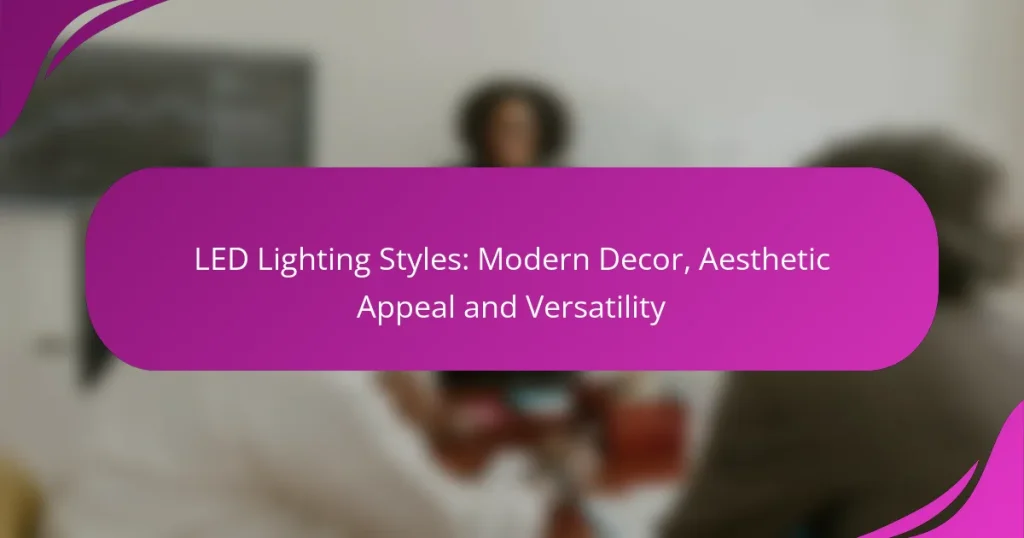LED lighting styles have become essential in modern decor, seamlessly blending aesthetic appeal with functionality and versatility. From minimalist fixtures to smart lighting systems, these options not only enhance the visual appeal of contemporary spaces but also provide practical illumination solutions. With a diverse range of colors and designs, LED lights transform environments while promoting energy efficiency and longevity.
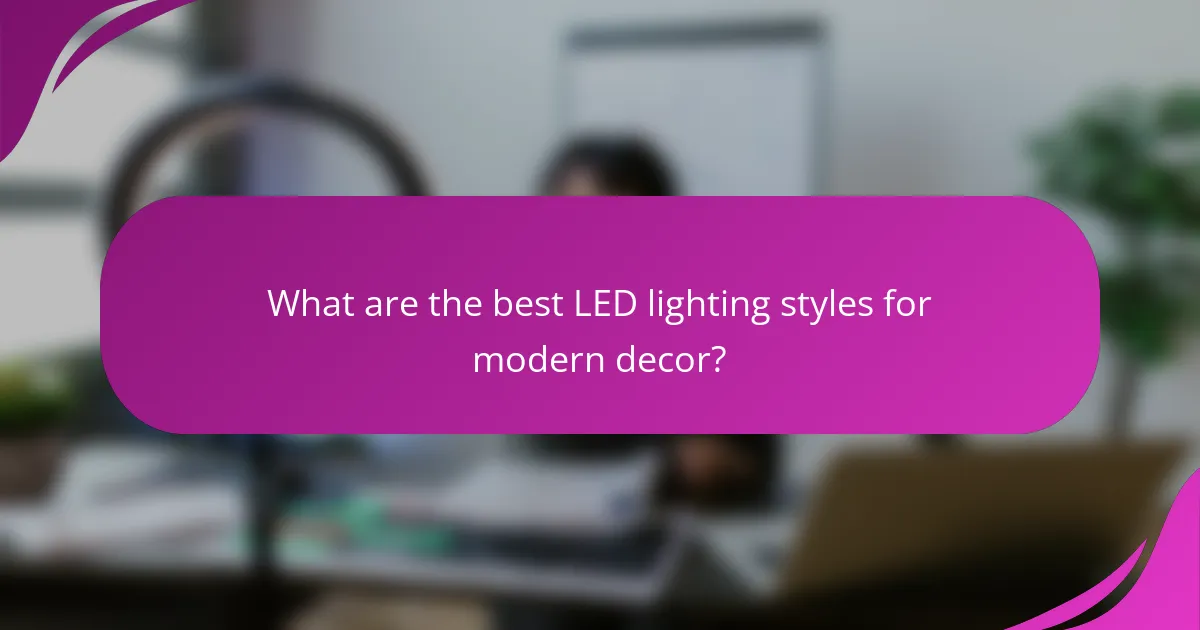
What are the best LED lighting styles for modern decor?
The best LED lighting styles for modern decor combine aesthetic appeal with functionality and versatility. Popular options include minimalist fixtures, smart lighting systems, industrial designs, and architectural accents, each offering unique benefits to enhance contemporary spaces.
Minimalist LED fixtures
Minimalist LED fixtures emphasize simplicity and clean lines, making them ideal for modern decor. These designs often feature sleek shapes and neutral colors, allowing them to blend seamlessly into various interiors.
When selecting minimalist fixtures, consider options like recessed lighting or pendant lights with geometric forms. These choices can create a streamlined look while providing effective illumination without overwhelming the space.
Smart LED lighting systems
Smart LED lighting systems offer advanced control and customization, making them a popular choice for modern homes. These systems can be adjusted via smartphone apps or voice commands, allowing users to change brightness and color temperature to suit different moods and activities.
When implementing smart lighting, ensure compatibility with your existing home automation systems. Look for options that support popular platforms like Google Assistant or Amazon Alexa for seamless integration.
Industrial LED designs
Industrial LED designs incorporate raw materials and rugged aesthetics, making them suitable for modern lofts and urban spaces. These fixtures often feature exposed bulbs and metal finishes, contributing to a trendy, unfinished look.
To achieve an industrial vibe, consider using pendant lights with Edison bulbs or track lighting with a metallic finish. These elements can add character while providing ample illumination in larger areas.
Architectural LED accents
Architectural LED accents highlight specific features within a space, such as artwork or structural elements. These lights can be integrated into walls, ceilings, or floors, creating a dramatic effect that enhances the overall design.
When using architectural accents, focus on placement to maximize impact. Consider using LED strips or spotlights to draw attention to focal points, ensuring that the lighting complements the surrounding decor without overpowering it.
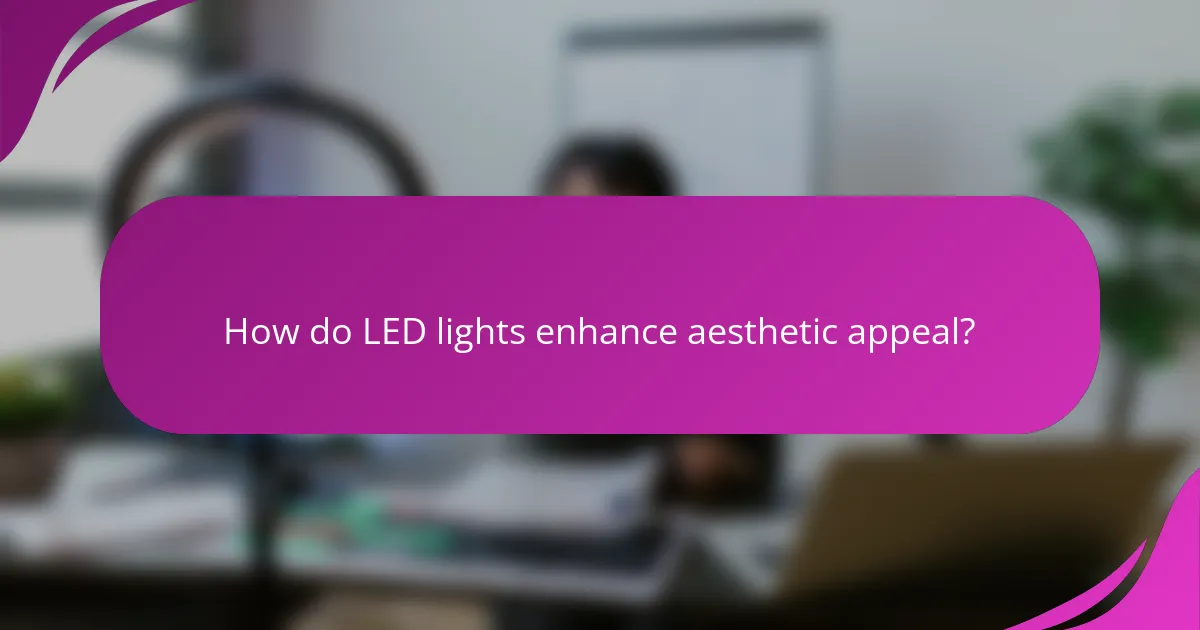
How do LED lights enhance aesthetic appeal?
LED lights significantly enhance aesthetic appeal by offering a wide range of colors, styles, and effects that can transform any space. Their versatility allows for creative lighting solutions that complement modern decor while providing functional illumination.
Color temperature options
LED lights come in various color temperatures, typically measured in Kelvin (K), which can influence the mood of a room. Options range from warm white (around 2700K) for a cozy atmosphere to cool white (up to 6500K) that mimics daylight. Choosing the right color temperature can enhance the overall aesthetic, making spaces feel inviting or energizing.
When selecting LED lights, consider the intended use of the space. For living areas, warmer tones are often preferred, while cooler tones are suitable for workspaces or kitchens. Experimenting with different temperatures can help achieve the desired ambiance.
Dynamic lighting effects
Dynamic lighting effects, such as dimming, color changing, and programmable patterns, add depth and interest to interior design. Many LED systems allow users to adjust brightness and color remotely, enabling customization for different occasions or moods. This adaptability can significantly enhance the visual appeal of a space.
For example, using LED strips under cabinets or along architectural features can create dramatic highlights. Additionally, smart LED systems can synchronize with music or events, providing an immersive experience that traditional lighting cannot match.
Energy-efficient design
LED lights are known for their energy-efficient design, consuming significantly less power than traditional incandescent or fluorescent bulbs. This efficiency not only reduces electricity bills but also minimizes environmental impact, making them a sustainable choice for modern decor.
When considering LED lighting, look for products with Energy Star ratings, which indicate compliance with strict efficiency guidelines. This ensures that you are choosing options that not only look good but also contribute to energy savings over time.
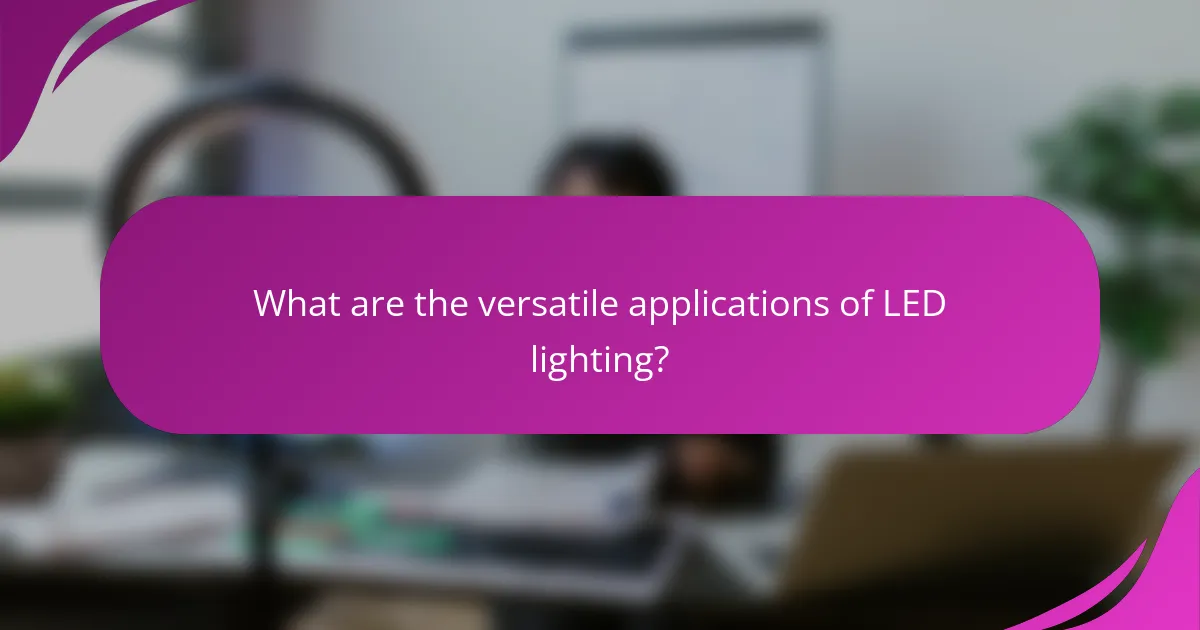
What are the versatile applications of LED lighting?
LED lighting offers a wide range of applications across various settings, making it a popular choice for both aesthetic and functional purposes. Its energy efficiency, longevity, and adaptability allow it to enhance residential, commercial, and outdoor environments effectively.
Residential lighting solutions
In residential settings, LED lighting can transform spaces with its versatility. From ambient lighting in living rooms to task lighting in kitchens, LEDs can be used in fixtures, recessed lights, and even decorative lamps. Homeowners often choose warm white tones for cozy environments or cooler tones for modern aesthetics.
Consider dimmable LED options to adjust brightness according to mood or activity. Installing smart LED systems allows for remote control and scheduling, enhancing convenience and energy savings.
Commercial space illumination
LED lighting is increasingly favored in commercial spaces due to its efficiency and low maintenance costs. Offices, retail stores, and restaurants benefit from bright, consistent lighting that enhances visibility and ambiance. Using LED panels or track lighting can create a professional atmosphere while reducing energy bills.
When designing commercial lighting, focus on the color temperature to match the brand’s identity. For example, cooler temperatures can promote alertness in office settings, while warmer tones can create a welcoming environment in hospitality venues.
Outdoor LED installations
Outdoor LED installations are ideal for enhancing safety and aesthetics in gardens, pathways, and building exteriors. Floodlights, landscape lights, and string lights can illuminate outdoor areas effectively while being energy-efficient. LEDs are also durable against weather conditions, making them suitable for year-round use.
When planning outdoor lighting, consider motion sensors for security and energy savings. Additionally, using solar-powered LED options can further reduce electricity costs while providing sustainable lighting solutions.
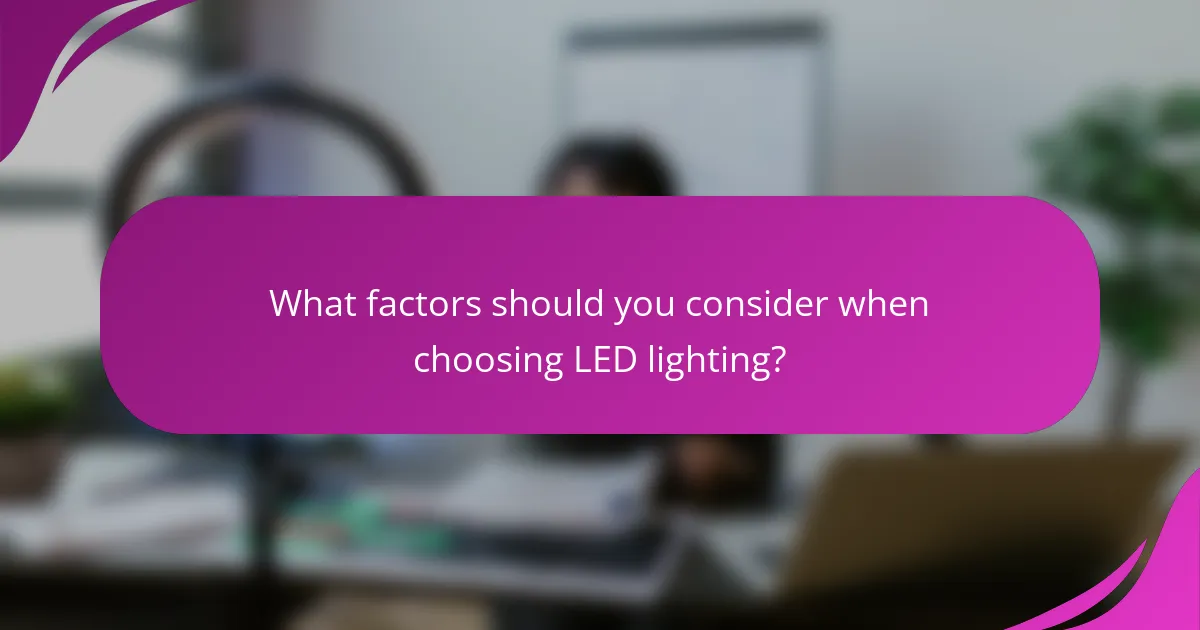
What factors should you consider when choosing LED lighting?
When selecting LED lighting, consider brightness, color rendering, installation requirements, and compatibility with existing fixtures. These factors significantly influence both the functionality and aesthetic appeal of your lighting choices.
Brightness and lumen output
Brightness in LED lighting is measured in lumens, which indicates the amount of light emitted. For general room lighting, aim for around 100-200 lumens per square meter, while task lighting may require higher outputs, typically between 300-800 lumens per square meter.
Keep in mind that higher lumen output does not always equate to better quality lighting. Consider the purpose of the space and balance brightness with energy efficiency to avoid excessive consumption.
Color rendering index (CRI)
The Color Rendering Index (CRI) measures how accurately a light source displays colors compared to natural light. A CRI of 80 or above is generally recommended for residential spaces, ensuring colors appear vibrant and true.
For areas where color accuracy is critical, such as art studios or retail spaces, look for LEDs with a CRI of 90 or higher. This enhances the visual appeal and helps in making informed decisions based on color perception.
Installation and compatibility
Before purchasing LED lighting, assess the installation requirements and compatibility with your existing fixtures. Many LED bulbs are designed to fit standard sockets, but some may require specific dimmers or transformers.
Check for compatibility with smart home systems if you plan to integrate your lighting with technology. Additionally, consider the ease of installation; some LED options are plug-and-play, while others may need professional installation for optimal performance.
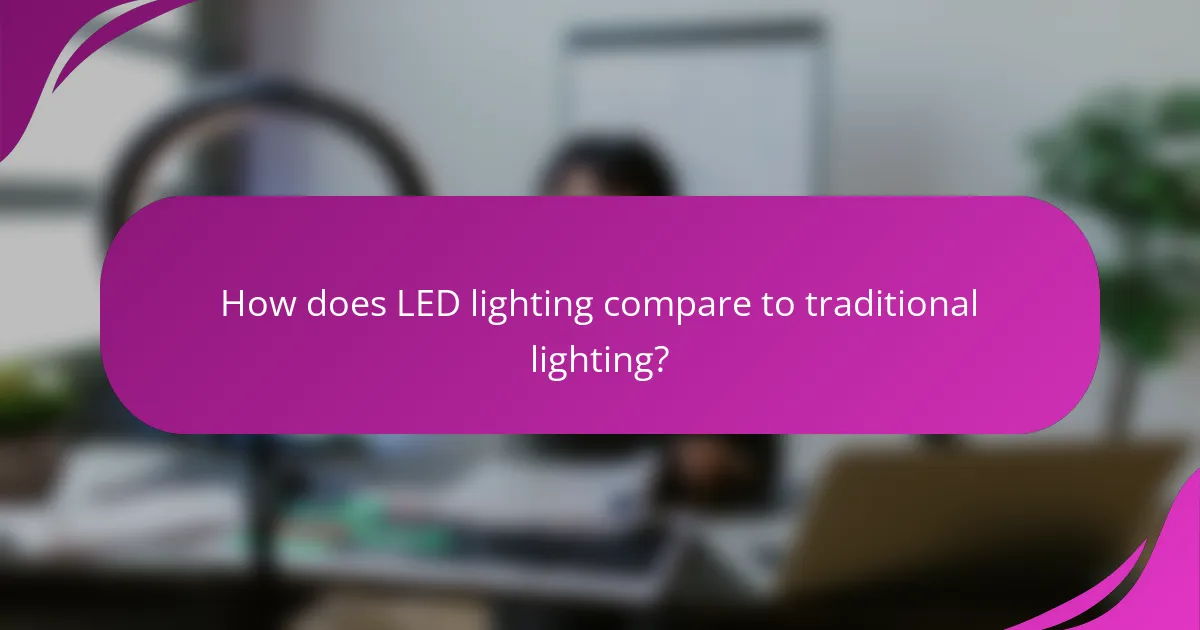
How does LED lighting compare to traditional lighting?
LED lighting offers significant advantages over traditional lighting, primarily in energy efficiency, longevity, and cost savings. While traditional bulbs consume more power and require frequent replacements, LEDs provide a more sustainable and economical lighting solution.
Energy consumption differences
LED lights consume considerably less energy than traditional incandescent or fluorescent bulbs. For instance, an LED bulb may use about 8-12 watts compared to a 60-watt incandescent bulb, resulting in energy savings of around 80-90%. This reduced energy consumption not only lowers electricity bills but also decreases the overall carbon footprint.
When considering energy efficiency, look for the Energy Star label, which indicates that the product meets strict energy efficiency guidelines set by the U.S. Environmental Protection Agency. This can help ensure you are choosing the most efficient options available.
Longevity and maintenance
LED bulbs typically last much longer than traditional lighting options, often exceeding 15,000 hours of use compared to the 1,000 hours for incandescent bulbs. This longevity means fewer replacements, which translates to less waste and lower maintenance costs over time.
Additionally, LEDs are more durable and resistant to breakage, making them suitable for various environments, including outdoor and high-traffic areas. Regularly check for any flickering or dimming, which can indicate a need for replacement or maintenance.
Cost-effectiveness over time
While the initial purchase price of LED bulbs may be higher than traditional bulbs, their long lifespan and energy savings make them more cost-effective in the long run. Over time, the savings on electricity bills can offset the higher upfront costs, often leading to a return on investment within a year or two.
To maximize cost-effectiveness, consider replacing multiple bulbs at once to take advantage of bulk purchasing discounts. Additionally, factor in local electricity rates, as regions with higher costs will see greater savings from switching to LED lighting.
